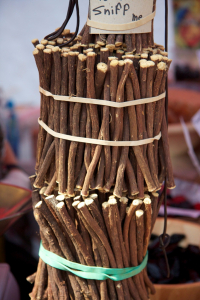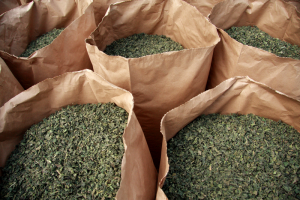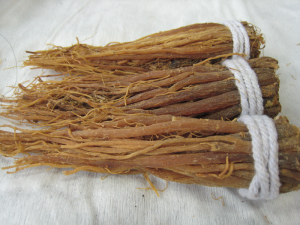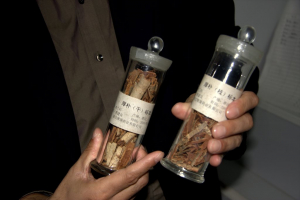Controlling the invisible trade: wild plant resources and their sustainability
22 June 2020
By Anastasiya Timoshyna, Zhang Ke, Yuqi Yang, Xu Ling, TRAFFICWith the current global spotlight on wild animal markets as a possible source of the COVID-19 epidemic, it is easy to forget that the biggest flows of “wildlife” in trade involve plants, not animals. There are also important conservation and health reasons to keep a close eye on the wild plant trade sector during this global health emergency. During the COVID-19 outbreak, the use of wild plants as herbal ingredients in traditional Chinese medicine formulations and other herbal-based products around the world is anticipated to increase dramatically. This article presents what is known about the trade in wild plant ingredients, the impact of COVID-19 on the demand and trade in these resources, and recommendations to the Customs community.
Scale of the trade and regulations
Approximately 60,000 plant species are used globally for medicinal purposes, of which about 28,000 have well-documented use, and approximately 3,000 species are traded internationally, with only one-third of them known to be in commercial cultivation[i].
The value of the global trade in medicinal and aromatic plant species has almost tripled in recent years, from 1.1 billion US dollars in 1999 to 3 billion in 2015, based on UN Comtrade data. This is an underestimate as in the international product nomenclature developed by the WCO, known as the Harmonized System or HS, the code from which the figure is derived does not cover all traded plants[ii] (HS 12.11 – Plants and parts of plants of a kind used primarily in perfumery, in pharmacy or for insecticidal, fungicidal or similar purposes, fresh, chilled, frozen or dried, whether or not cut, crushed or powdered). One comprehensive review suggests that in 2013, China exported over 1.3 billion kg of plant materials, with a reported Customs value of over 5 billion US dollars, to which wild-collected produce may have contributed as much as 1.8 billion[iii].
It is assessed that direct overexploitation, including for international trade, combined with land-use changes and habitat loss, threatens the survival of as many as 20% of the plants used for medicinal and aromatic purposes. The extinction of these species threatens the livelihoods and well-being of millions of wild harvesters in poor and marginalized regions around the world. The fact that wild plant supply chains often operate under complex legality, with much of the trade being informal, reinforces the idea that some of the trade is under-reported.
The trade in some of these plants is regulated. At the international level, CITES lists 800 species of medicinal and aromatic plants (MAPs) in Appendix II, which includes species not necessarily threatened with extinction, but trade in which must be controlled in order to avoid utilization incompatible with their survival.

Trade data shows that, from 2006-2015, 43 CITES Appendix II wild species were traded legally (i.e. accompanied by CITES documents) – some 25,000 tonnes in total. According to importers’ annual reports, the top three exporting countries were Mexico, Cameroon, and South Africa, together representing 75% of all wild-sourced exports, while five countries were responsible for 77% of imports: France (26%), US (16%), Japan (15%), Germany (11%), and Spain (7%). According to importers’ data, the trade in Candelilla Euphorbia antisyphilitica and African Cherry Prunus africana accounted for 73% by volume of all CITES-listed plants. Significant trade was also recorded for aloes Aloe spp., orchids Dendrobium spp., and agarwoods Aquilaria spp. Jatamansi Nardostachys jatamansi exports from Nepal also appear to be globally significant according to data reported by exporters.
There is also evidence of illicit trade as exemplified by the analysis of CITES-related seizures reported by European Union (EU) Member States[iv]. During 2018, 23% of all seizures reported were of medicinal plant and animal products and parts/derivatives for medicinal use. This included 260,562 plant-derived medicinal items (and an additional 6,685 kg and 23 lt), with many Appendix II-listed MAPs seized, including aloe Aloe maculate, Gastrodia elata and Dendrobium nobile orchids, and Prunus africana.
Many of the seized products contain CITES Appendix-II listed plant species, suggesting some are linked to poor compliance with, rather than an intentional violation of, CITES regulations. This may be linked to a lack of understanding of CITES requirements along trade chains, and/or capacities to implement the regulations in source and transit countries.
At the national level, the control of use and trade are often covered by different legislative requirements, including the establishment of access and resource-use regimes, the protection of species and habitats, consumer protection, and the establishment of intellectual property regimes. The US Lacey Act, for example, now requires a declaration of legal sourcing at the time of import of certain plants and plant products since its amendment in 2008. In 2017, a US manufacturing company was prosecuted and fined for non-compliance with the Act[v]. It is worth noting that the declaration requirement has been implemented in phases and that phase six of the enforcement schedule, which will go into effect from 1 October 2020, includes certain essential oils[vi].
What is the relevance to issues surrounding COVID-19?
Many plants are recommended as either formal or informal COVID-19 treatments, or for general wellbeing worldwide.

In China, plants comprise around 80% of traditional Chinese medicine (TCM) products. An estimated 30% of TCM industrial production volume is from wild plants, accounting for 70% of the species by number. Both TCM and Western treatments are used to treat COVID-19 patients, with official treatments issued by China’s National Health Commission. One study[vii] screened 125 Chinese herbal medicines for the potential to inhibit COVID-19 directly, and evidence of SARS and H1N1 influenza prevention has been reviewed[viii].
The current official treatment plan[ix] includes 10 TCM prescribed formulations and 13 proprietary Chinese medicine formulations (including granules, capsules, injections), which utilize over 125 plant species. They include Licorice root Glycyrrhiza spp, a protected species in parts of its Chinese range, used in 11 formulations, and several CITES Appendix II-listed species: Ginseng root Panax spp, and Cibotium barometz. Panax ginseng and Magnolia officinalis are grade-II listed on China’s protected species and nationally important protected medicinal plant lists, requiring their harvesting and trade to take place only with a provincial authorities’ permit, and under their oversight. A subset of these species is likely to be sourced from the wild, in China and internationally.

An increase in the volume of trade in herbal products in China, driven by COVID-19 prescriptions[x], has taken place and likely elsewhere. There are reported “rushes for traditional herbal medications” against COVID-19 in Thailand[xi], ”immune-boosting” herbal capsules promoted in India[xii], traditional government-promoted herbal medicines against coronavirus in Bolivia[xiii], and increased use of traditional remedies in Tunisia[xiv]. India’s Ministry of AYUSH issued a statement on “Ayurveda’s immunity-boosting measures for self-care during the COVID-19 crisis[xv],” which includes the recommendation to take a Chyavanprash formula (containing a range of wild plant ingredients) daily. Research suggests infusing nano-fibre respiratory masks with medicinal plants[xvi]. There are reports of Cameroonians taking a herbal COVID-19 “cure”[xvii], and the President of Madagascar has been promoting a herbal drink as a treatment[xviii],[xix]. There is also a reported rapid increase in the demand for traditional Chinese remedies for respiratory and other ailments in the US[xx].
Why does it matter and what should be done?
While current research and attention focus on the likely efficacy of herbal medicines to support health care, there is a lack of attention to ensuring the sustainability of supply chains. This is particularly important for plants sourced from the wild. Indeed, only one-third of the plant species in international trade for medicinal and aromatic purposes is estimated to be in commercial cultivation.

Challenges around trade in wild plant ingredients include increasing demand, as well as complex trade chains and traceability issues. There are also identification issues, as plants are mostly traded as parts, derivatives, and finished products, including in mixed and processed form. Conversely, market awareness of sustainability issues is growing, and best practices are available, as well as some policy and legislative frameworks (notably including CITES regulations), creating opportunities for establishing the conditions for sustainable and legal trade in wild plants, benefiting livelihoods, ecosystems, and other species, as well as providing healthcare opportunities and food security.
Within China, recent efforts[xxi] have provided insights into the industrial production of TCM products, identifying key gaps around the sustainability of supply chains, and providing practical solutions to address them. Solutions include the application of TCM-sector corporate sustainability guidelines, together with international best practices such as the FairWild Standard[xxii]. Beyond China, the Belt and Road Initiative (BRI) includes a TCM strategy[xxiii], which focuses on the rapid expansion of TCM centres around the world, providing opportunities to advance sustainable-use practices. The “greening” of this strategy is key to ensuring the long-term survival of medicinal and aromatic plant species.
The future availability of plant ingredients to support human health is dependent on prioritizing the long-term conservation and sustainable use of source species, which necessitates much greater action from governments, the private sector, and consumers.
Priority actions/recommendations for the Customs community include:
- Increasing Customs officers’ awareness of the scale and importance of trade in wild plant products and ensure effective monitoring and control of the trade.
- Encouraging relevant services to collaborate with the CITES Secretariat, national authorities, and relevant non-governmental organizations (NGOs), to propose and adopt species-specific Customs codes for plants in reporting national statistics. Only a few plants have an HS code at the six-digit level. In the 2022 edition of the HS, a new position was created for one species, African Cherry Prunus africana, but many other plants have to be classified under the generic “other” position.
- Collaborating with NGOs, the CITES Secretariat, and other relevant organizations to analyse existing seizure data in order to identify underlying causes for the illegal trade in Appendix II-listed medicinal plant species. This would help to identify knowledge, awareness or capacity gaps, and, in the long-term, reduce the illegal trade/number of seizures of Appendix-II listed species.
- Collaborating with plants authorities and relevant NGOs, to conduct capacity building, focusing on laws, procedures, and systems, enforcement coordination, and the identification of plant products.
- Collaborating across source, transit, and consumer countries to exchange information, data, and intelligence on CITES-listed and nationally protected plant species, including trade and harvesting bans, high tariffs, quotas, etc. This could be achieved through the adaptation of the Guidelines for Verifying Timber Legality for Customs, which was developed with the support of the WCO.
- Participating in a multi-stakeholder discussion to review existing national laws and policies covering the harvest and trade in wild plant resources in order to ensure the legality of species harvest and trade, and to identify potential gaps or loopholes in the existing regulatory and policy frameworks, especially where international trade is a concern.
More information
anastasiya.timoshyna@traffic.org
https://www.traffic.org/what-we-do/species/wild-plants/
[i] Jenkins, M., Timoshyna, A., & Cornthwaite, M. (2018). Wild at Home: Exploring the global harvest, trade and use of wild plant ingredients.
[ii] Sorrenti, S. 2017. Non-wood forest products in international statistical systems. Non-wood Forest
Products Series no. 22. Rome, FAO.
[iii] Brinckmann, J. A. (2016). Sustainable Sourcing: Markets for certified Chinese medicinal and aromatic plants. Geneva: International Trade Centre, 22.
[iv] TRAFFIC (2019). Overview of seizures of CITES-listed wildlife in the European Union—January to December 2018.
Retrieved from: https://ec.europa.eu/environment/cites/pdf/reports/EU-seizures-report-2018-FINAL%20(rev%2009-04-20).pdf
[v] https://www.justice.gov/opa/pr/essential-oils-company-sentenced-lacey-act-and-endangered-species-act-violations-pay-760000
[vi] https://www.aphis.usda.gov/aphis/newsroom/stakeholder-info/sa_by_date/sa-2020/sa-03/lacey-act-phase-six
[vii] Zhang, D. H., Wu, K. L., Zhang, X., Deng, S. Q., & Peng, B. (2020). In silico screening of Chinese herbal medicines with the potential to directly inhibit 2019 novel coronavirus. Journal of Integrative Medicine, 18(2), 152-158. https://doi.org/10.1016/j.joim.2020.02.005
[viii] Luo, H., Tang, Q., Shang, Y. et al. Can Chinese Medicine Be Used for Prevention of Corona Virus Disease 2019 (COVID-19)? A Review of Historical Classics, Research Evidence and Current Prevention Programs. Chin. J. Integr. Med. (2020). https://doi.org/10.1007/s11655-020-3192-6
[ix] http://www.nhc.gov.cn/yzygj/s7653p/202003/46c9294a7dfe4cef80dc7f5912eb1989.shtml
[x] For example https://www.nutraingredients-asia.com/Article/2020/04/29/COVID-19-and-TCM-Thailand-and-Laos-embrace-China-approved-Lianhua-Qingwen-Capsule-product
[xi] https://www.bangkokpost.com/thailand/general/1880490/covid-19-fear-fuels-rush-for-traditional-herbal-medication
[xii] https://economictimes.indiatimes.com/magazines/panache/covid-19-boost-your-immunity-with-dalmia-groups-herbal-capsule/articleshow/74684873.cms
[xiii] https://www.nytimes.com/reuters/2020/03/21/world/americas/21reuters-health-coronavirus-bolivia-tradition.html
[xiv] https://www.middleeasteye.net/video/tunisians-turn-traditional-herbal-medicines-amid-coronavirus-fears
[xv] http://ayush.gov.in/sites/default/files/Immunity%20Boosting%20-%20%20AYUSH%20Advisory.pdf
[xvi] https://www.port.ac.uk/news-events-and-blogs/news/herbal-medicine-might-help-battle-against-covid-19
[xvii] https://www.voanews.com/covid-19-pandemic/hundreds-rush-popular-clerics-herbal-covid-cure-cameroon
[xviii] https://www.dw.com/en/covid-19-who-cautions-against-the-use-of-traditional-herbs-in-africa/a-53341901
[xix] https://www.sciencemag.org/news/2020/05/unproven-herbal-remedy-against-covid-19-could-fuel-drug-resistant-malaria-scientists
[xx] https://www.reuters.com/article/us-health-coronavirus-usa-herbs/u-s-coronavirus-threat-fuels-demand-for-traditional-herbal-remedies-idUSKBN20W2GR
[xxi] Engaging China’s private sector in sustainable management of medicinal plants project website: https://www.traffic.org/what-we-do/projects-and-approaches/promoting-sustainable-trade/fairwild/egp-maps/
[xxii] FairWild Standard Version 2.0 (2010), retrieved from: https://www.fairwild.org/s/FairWild-Standard-V2.pdf
[xxiii] Hinsley, A., Milner-Gulland, E.J., Cooney, R. et al. Building sustainability into the Belt and Road Initiative’s Traditional Chinese Medicine trade. Nat Sustain 3, 96–100 (2020). https://doi.org/10.1038/s41893-019-0460-6

